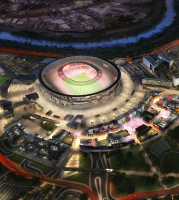
Designed in 1927 and originally called Stadio dei...
Designed in 1927 and originally called Stadio dei Cipressi (in Spanish: 'Stadium of the Cypresses'), it was designed and built within the framework of the project to create an authentic sports city that would be called Mussolini Forum (and which after the war was renamed "Italic Forum"). Construction work began in 1928 and ended in 1937 under the supervision of architect Luigi Walter Moretti.
During the 1960 Olympics the stadium hosted the opening and closing ceremonies and the athletic competitions
Historical sports structure with cemetery architec...
Historical sports structure with cemetery architecture
It was very nice
It was very nice
See the players
Visibility is very bad, the athletics track keeps ...
Visibility is very bad, the athletics track keeps the field far away. There are no services, you can only eat extremely scarce things.
When I am at the Olimpico in Rome I always think o...
When I am at the Olimpico in Rome I always think of the Olympic stadium in Berlin, Barcelona, Paris but also to minors, such as Tallin, Athens or Malta etc.
No dedicated metro stops, like the ones mentioned above, no possibility of human parking, as above happens, no convenient shuttle (some from Piazzale Flaminio that take an hour to arrive)!
Few arteries to get in and out, inefficient turnstiles, traffic signs, cabbage lights.
In short, if it were not that inside it is very beautiful, aesthetically because structurally it is a toilet, less than a star.
But that's okay: this is Italy
The stadium is aesthetically beautiful but with ma...
The stadium is aesthetically beautiful but with many problems. The athletics track does not allow the visitor to be near the field, the billboards behind the door do not make it clear whether the ball enters the net or not. Few parking lots nearby.
High rating only because my favorite team plays it.
